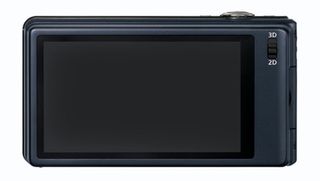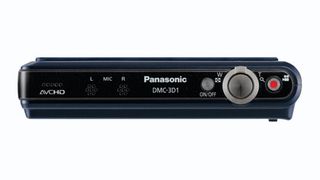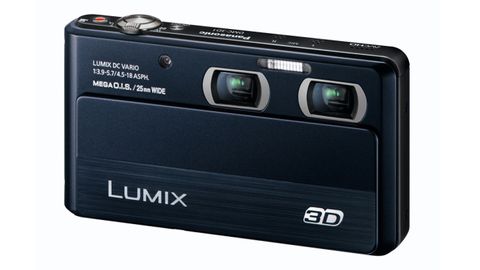Why you can trust TechRadar
In terms of design, the Panasonic Lumix 3D1 is minimalist in the extreme - and from the front at least, similar to the Fuji W3, thanks to a sliding cover that takes up two-thirds of the camera. Slipping it down switches the camera on and reveals the two lenses and a small flash.
The Fuji W3's lenses are positioned towards the edges of the camera, with a 75mm spacing that's slightly wider than the typical 65mm spacing of human eyes. While this may be good for enhancing the amount of parallax captured by the lenses, it's not always useful for handling: fingers can easily stray into the frame.
The Panasonic 3D1's lenses are only spaced around 35mm apart and positioned to the left of the camera (as you look down on it). You do still have to be careful while handling the camera, but its smaller size and weight means it's a bit more manageable.

Around the back of the Panasonic Lumix 3D1, things are equally as bare. The 3.5-inch, widescreen 460k-dot Smart Touch Screen LCD display dominates the camera. The only physical control here is a subtle 3D/2D switch, positioned in the top-right corner, and there's no grip to speak of (there isn't room for one).
Touchscreens on cameras are still at that awkward early stage of development. In theory, they make photography faster and more intuitive, removing the barriers of fiddly buttons and dials. In practice, they often prove slow and imprecise.
Panasonic even includes a plastic stylus in the box for increased accuracy.
Thankfully, we didn't need to reach for the stylus. The Panasonic Lumix 3D1's touchscreen is one of the more effective examples of the tech that we've seen on a compact camera, and It makes fairly light work of operation.

Yes, there's some to-ing and fro-ing between icons and menus in order to get to some of the camera's features, and there are only two shortcut controls that you can add to the main screen (we opted for exposure compensation and ISO). But in terms of responsiveness, it puts in a surprisingly sprightly performance.
Don't expect too much by way of manual control, though. In 2D mode, you're limited to four automatic modes: Intelligent Auto, Dual-Shot, Record Mode and Scene Mode.
In Record Mode, you can change ISO, adjust exposure compensation (from -2EV to +2EV) and white balance (there are only four presets here - daylight, cloudy, shade, incandescent - plus auto and manual).

There's a selection of the usual Panasonic Intelligent functions, such as i.Resolution and i.Exposure, that can be toggled on or off. But that's pretty much it in terms of hands-on picture-taking adjustments.
In 3D Mode, there's even less to do. You can't alter ISO or white balance, for instance. You can change the strength of the 3D effect by shifting the parallax (from -2 to +2), but because the camera doesn't offer a way of viewing 3D images, it's only something you'll be able to effectively gauge through experience.

